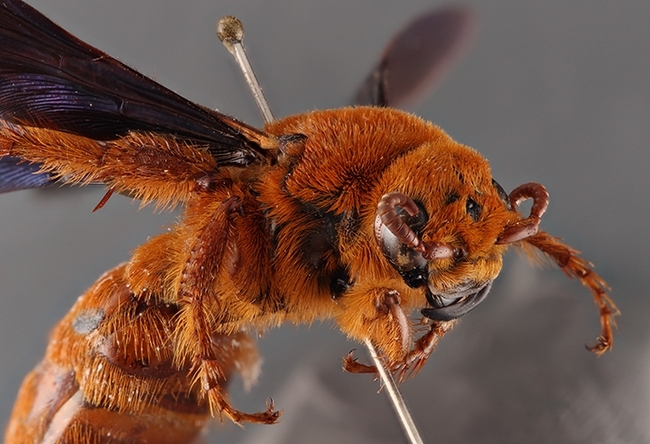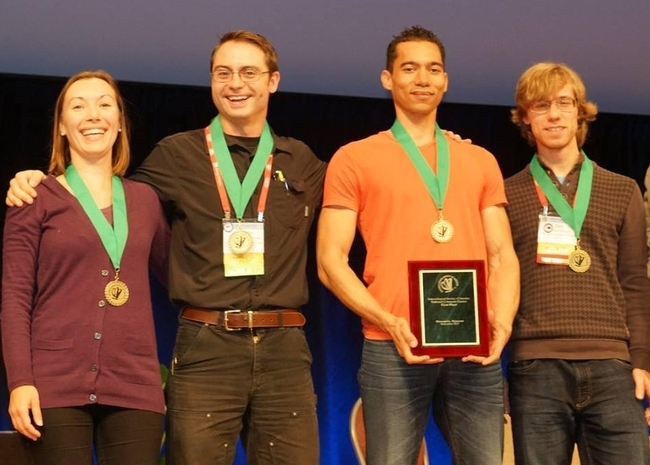
Khouri will present his seminar in-person at 4:10 p.m. (Pacific Daylight Time) in 122 Briggs Hall and via Zoom. The Zoom link is https://ucdavis.zoom.us/j/99515291076
"Ziad's work on the mammoth wasps is unique," said host Kimsey, director of the Bohart Museum of Entomology and a distinguished professor of entomology. "This is a family of large bodied distinctive parasitoid wasps that have never had a modern systematic treatment, and the genus and species level taxonomy was a mess. He has brought together modern and classical techniques to bring taxonomic order to this family of wasps and discovered how they evolved."
The Bohart Museum, home of a global collection of eight million insect specimens, houses some 2300 mammoth wasp specimens, mostly from the Americas, Korea and South Africa.
Khouri will deliver his seminar in two parts: "The Evolutionary History of Mammoth Wasps (Hymenoptera: Scoliidae)" and "Comparing the Power of Data-Based Phylogenetic Posterior Predictive Checks in the Context of Cucleotide and Amino Acid Data."
Khouri shares these abstracts from his seminar:
Part 1: "The Evolutionary History of Mammoth Wasps (Hymenoptera: Scoliidae)"
Scoliid wasps comprise a clade of aculeate insects whose larvae are parasitoids of scarabaeid beetle grubs. While scoliids have been studied and used as biological control agents, research into the group's evolution, as well as the stability of scoliid taxonomy, has been limited by a lack of reliable phylogenies. We use ultraconserved element (UCE) data under concatenation and the multispecies coalescent to infer a phylogeny of the Scoliidae. In order to mitigate potential issues arising from model misspecification, we perform data filtering experiments using posterior predictive checks and matched-pairs tests of symmetry. Our analyses confirm the position of Proscolia as sister to all other extant scoliids. We also find strong support for a sister group relationship between the campsomerine genus Colpa and the Scoliini, rendering the Campsomerini non-monophyletic. Campsomerini excluding Colpa (hereafter Campsomerini sensu stricto) is inferred to be monophyletic, with the Australasian genus Trisciloa recovered as sister to the remaining members of the group. Many sampled genera, including Campsomeriella, Dielis, Megascolia, and Scolia are inferred to be non-monophyletic. Analyses incorporating fossil data indicate an Early Cretaceous origin of the crown Scoliidae, with the split between Scoliini + Colpa and Campsomerini s.s. most probably occurring in the Late Cretaceous. Posterior means of Scoliini + Colpa and Campsomerini s.s. crown ages are estimated to be in the Paleogene, though age 95% HPD intervals extend slightly back past the K-Pg boundary, and analyses including fossils of less certain placement result in more posterior mass on older ages. Our estimates of the stem ages of Nearctic scoliid clades are consistent with dispersal across Beringia during the Oligocene or later Eocene. Our study provides a foundation for future research into scoliid wasp evolution and biogeography by being the first to leverage genome-scale data and model-based methods. However, the precision of our dating analyses is constrained by the paucity of well-preserved fossils reliably attributable to the scoliid crown group. Despite concluding that the higher-level taxonomy of the Scoliidae is in dire need of revision, we recommend that taxonomic changes be predicated on datasets that extend the geographic and taxonomic sampling of the current study.
Part II: "Comparing the Power of Data-Based Phylogenetic Posterior Predictive Checks in the Context of Cucleotide and Amino Acid Data"
When used for phylogenetic inference, exonic DNA sequences can be coded in multiple ways, including as nucleotides, amino acids, and codons. In empirical studies, the choice of data type and associated model is often predicated on which model is less expected to be violated in ways that lead to inaccurate inference. Posterior predictive checks are one method for assessing the adequacy of phylogenetic models and potentially providing an indication of inference reliability. We used a simulation-based approach to explore how our ability to detect model inadequacy using phylogenetic posterior prediction, as well as the associated inference errors, may vary with data coding. Specifically, we simulated data under multiple models, including codon models featuring process heterogeneity across lineages, selection heterogeneity across sites, and selection for codon usage. We then performed inference and posterior predictive checks under nucleotide and amino acid models from the GTR family. We found that some simulation conditions resulted in significant differences, between amino acid and nucleotide treatments, in our ability to detect model violation, even when the magnitude of error in an estimate of interest was similar. Moreover, we corroborate the results of other studies indicating that error in tree length estimation is not always correlated with error in topology reconstruction. Although the use of amino acid models generally resulted in more accurate topologies, we found tree length errors to often be greater than for nucleotide models when the data being analyzed were generated using branch-heterogeneous codon models. We show that the magnitude and direction of tree length estimation error can depend on both data coding and properties of the data-generating process. We conclude that if posterior predictive checks are to be used for purposes such as data filtering, practical effect size thresholds indicative of low inference reliability must be established separately for amino acid and nucleotide data. We also advise caution and recommend careful selection of models and data coding when performing analyses where accurate inference of tree length is important.
Khouri joined the UC Davis graduate program in 2012 and is pursuing his doctorate in entomology. His dissertation research involves the phylogenetics, evolution and taxonomy of Scolliidae (Hymenoptera) and phylogenetic posterior prediction. He holds a bachelor's degree in biology (2012) from Notre Dame University - Louaize (NDU).
He did undergraduate research on the identification of bee and other pollinator specimens at the American University of Beirut; assessed genetic diversity in Spartium junceum populations (known as Spanish broom, rush broom, or weaver's broom); and collected specimens for the establishment of an insect collection at NDU. Khouri was a member of the UC Davis team that won the national Linnaean (now Entomology) Games at the 2015 Entomological Society of America meeting. The UC Davis team defeated the University of Florida, winning the competition for its first time in the Games' 32-year history. (See video)
The Bohart Museum, located in Room 1124 of the Academic Surge Building on Crocker Lane, is currently closed to the public. It houses eight million insect specimens, as well as a live "petting zoo" (Madagascar hissing cockroaches, stick insects and tarantuias) and an insect-themed gift shop, now online.
Nematologist Shahid Siddique, assistant professor, UC Davis Department of Entomology and Nematology, coordinates the seminars. For any Zoom technical issues, contact Siddique at ssiddique@ucdavis.edu. (See list of seminars)
Attached Images:

This specimen from the Bohart Museum of Entomology is a mammoth wasp, Trisciloa saussurei, a native of New Guinea. (Photo by Ziad Khouri)

Ziad Khouri (far right) was a member of the UC Davis team that won the national Linnaean (now Entomology) Games at the 2015 Entomological Society of America meeting. With him (from left) are Jessica Gillung, Brendon Boudinot, and captain Ralph Washington Jr. (Photo by Matthew Chism)